Healthy Aging: Why Functional Strength Beats Endless Cardio
When most people think about aging well, the first thing that comes to mind is cardio. Walking, jogging, cycling, or hours on the treadmill—activities that keep the heart and lungs strong. And while cardiovascular health is undeniably important, there’s a bigger factor that often gets overlooked: functional strength.
The truth is simple: without functional strength, cardio endurance won’t matter. If you can’t rise from a chair without using your arms, or you need 100% of your strength just to climb stairs, your independence is already at risk. Cardio alone cannot save you from that decline.
Why Functional Strength Matters for Healthy Aging
Functional strength is the ability to move your body through real-world patterns—squatting, hinging at the hips, pushing, pulling, carrying, and balancing. It’s not about bodybuilding or lifting the heaviest weights. It’s about having enough strength in reserve to perform daily activities safely, efficiently, and with confidence.
Here’s why that matters more than endless cardio:
1. The Chair Test: Independence in a Single Movement
Being able to get up from a chair without using your hands is one of the strongest predictors of functional independence. If this ability is lost, people start avoiding activity—not because they lack endurance, but because they lack strength. Less activity leads to muscle wasting, joint stiffness, and eventually, chronic disease.
2. The Stair Problem: Strength as a Buffer
If walking up stairs requires all of your available strength, you leave no buffer for balance or coordination. One small slip, and you fall. This is why falls are the leading cause of injury-related deaths in adults over 65. Cardio endurance won’t stop a fall if you don’t have the muscular strength to stabilize yourself.
3. Strength Loss Triggers Decline in Activity
It’s a vicious cycle: once functional strength drops, people reduce activity, which then accelerates further decline. Even if your heart and lungs are in great shape, they won’t matter if you stop moving because your muscles can’t keep up.
The Overlooked Truth: Strength Training Helps Cardio Too
Many older adults think they need to “pick” between cardio and strength. But here’s the overlooked truth: strength training boosts cardiovascular health too.
Heart rate response – Lifting weights raises your heart rate and challenges circulation, improving baseline cardiovascular health.
Blood pressure & cholesterol – Research shows strength training reduces blood pressure and improves blood lipid profiles.
Endurance carryover – A stronger body makes walking, climbing, or biking easier because you’re using less of your total strength reserve for each action.
In short: you don’t need to run marathons to keep your heart healthy. A strength-focused program provides both muscular independence and enough cardiovascular stimulus to protect long-term heart health.
Functional Strength vs. Traditional Cardio: Which Matters More?
CategoryStrength TrainingCardio TrainingDaily IndependenceHigh impact: sit-to-stand, stair climbingLimited carryoverFall PreventionBuilds reserve for balance & stabilityDoes not address strength deficitsCardiovascular HealthImproves above baselineStrong benefitsLongevityStrong predictor of reduced mortalityAlso linked to longer lifeRisk of Overuse InjuriesLower if varied movements are usedHigher with repetitive stress
Both are important—but if you’re forced to prioritize, functional strength gives you more practical independence as you age.
How to Build Functional Strength
The good news: building functional strength doesn’t require fancy equipment or a gym membership. It’s about practicing the same movements you need in daily life, with progressive resistance to keep improving.
Core Movements to Train
Squats – For sitting, standing, and stairs. Start with chair squats.
Hip hinges – For lifting safely. Try hip bridges or deadlifts with light weights.
Pushes & pulls – For opening doors, carrying groceries, or getting up from the floor. Push-ups (wall or floor) and rows work well.
Carries – For grocery bags or suitcases. Farmer’s carries with dumbbells or even water jugs are effective.
Balance drills – Standing on one leg, heel-to-toe walks, or step-ups build stability.
General Guidelines
Train 2–3 times per week.
Focus on proper form before increasing load.
Use resistance bands, light dumbbells, or bodyweight if starting from scratch.
Progress gradually—functional strength builds steadily with consistency.
Functional Strength for Longevity
Studies consistently show that muscle strength is one of the strongest predictors of longevity. People with higher strength levels live longer—not just because they can move better, but because muscle tissue itself protects against metabolic diseases, frailty, and falls.
Even modest strength training—two 30-minute sessions per week—significantly reduces the risk of disability, hospitalization, and mortality in older adults.
Key Takeaways
Cardio is important—but functional strength is more critical for independence.
Without strength, cardio fitness doesn’t matter: you won’t stay active if you can’t move safely.
Functional strength reduces fall risk, maintains independence, and improves cardiovascular health above baseline.
Strength training and cardio are not opposites—strength builds the foundation for both.
For healthy aging, prioritize strength first, then supplement with cardio.
Bottom Line — Healthy aging isn’t about outpacing your neighbor in a 5K. It’s about having the strength to get up, move freely, climb stairs without fear, and carry on with life’s activities. Cardio supports your health, but functional strength preserves your independence—and independence is the truest measure of longevity.

